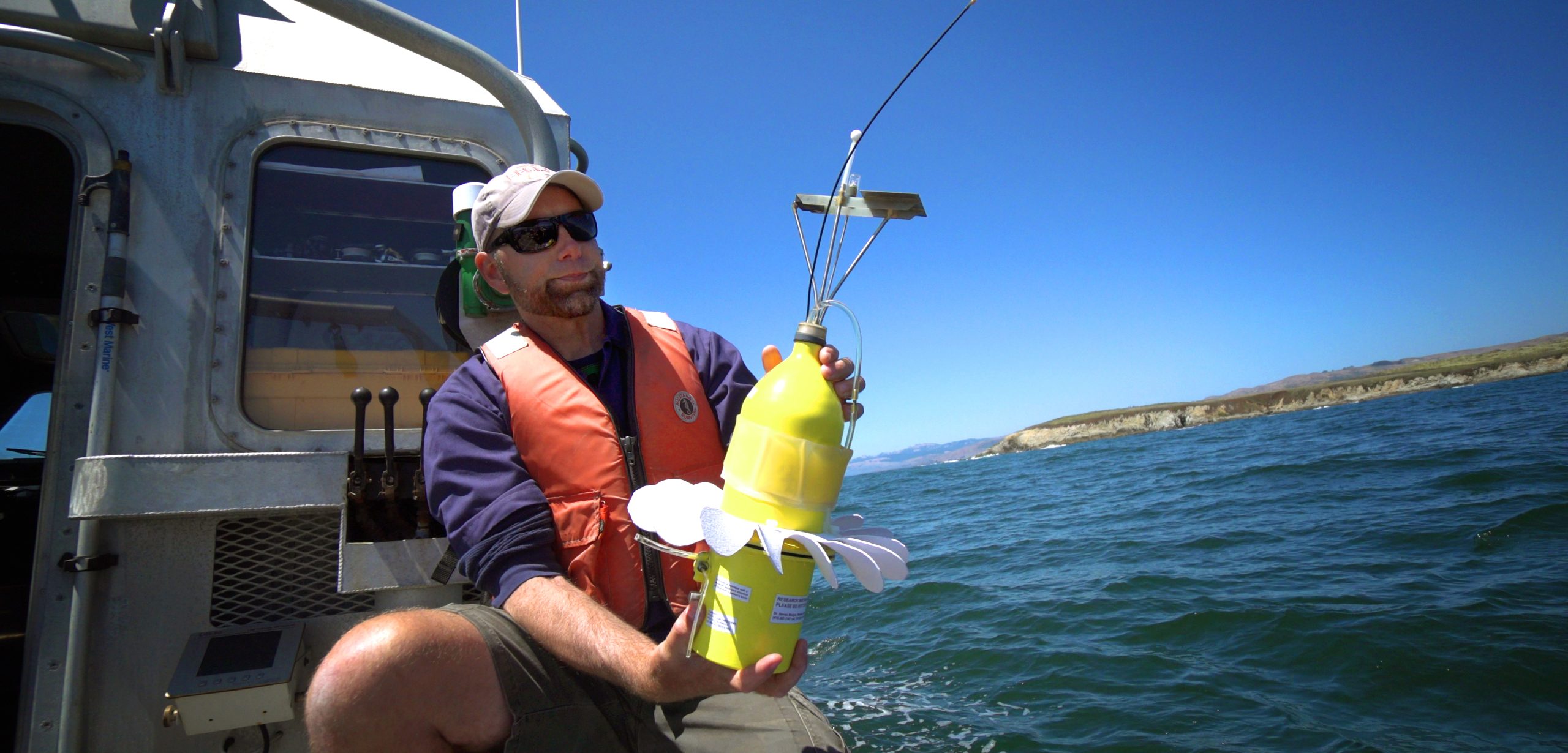This Robot Thinks It’s a Larva
A new robot is designed to mimic the behavior of teeny tiny larvae.
Article body copy
One by one, four bright yellow robots drop into the water in northern Bodega Bay, along California’s north-central coast. Two minutes later the robots’ pumps kick in, and the fleet submerges beneath the waves. On a typical run, these bots—built from the husks of spent fire extinguishers, and looking a little like Minions in tutus—will swim up and down through the water column, and between currents moving in different directions. And at the end of their run, scientists will know a little bit more about one of the most critical phases of life for many marine species.
For years, scientists have assumed that the minuscule larval forms of many species, from crabs and oysters to corals and fishes, are free-floating organisms fully at the mercy of ocean currents. Yet over the past 15 years, marine ecologist Steven Morgan and others have found increasing, though indirect, evidence of marine larvae taking control of their fates.
Using lab and field observations, scientists have inferred a range of larval behaviors, such as an ability to migrate daily up and down the water column to feed or avoid predators. Larvae also migrate vertically into different currents, which act as conveyer belts, taking them farther away from or closer to shore depending on their stage of development.
Many marine species spend the first half of their lives as larvae, says Morgan, yet scientists’ understanding of exactly where and how they move through the ocean is extremely limited. For most animals, a satellite tracking tag would be the go-to solution. But most larvae are the size of a pinhead or even smaller, which makes even the tiniest satellite tags—currently used for bees—far too large.
To overcome that, Morgan partnered with Tom and Donna Wolcott who, over the course of 35 years, designed bright yellow robotic larvae to serve as stand-ins for actual larvae.

Research has shown that larvae move vertically within the water column, using currents to maintain or change their position—a behavior that is reproduced by the larva robot. Animation by UC Davis Bodega Marine Laboratory
Morgan and the Wolcotts, a husband-and-wife team of semi-retired ecologists from North Carolina State University, are now programming known larval behaviors into their robots.
“What we’re really doing is trying to get good data on the consequences of these behaviors,” says Morgan.
So far, the Wolcotts have built 25 robotic larvae using expired fire extinguishers as a base (“it was just about the right thickness” for ocean depths of 100 meters, says Tom), and outfitting them with various instruments.
The Wolcotts equipped their bots with light sensors to tell night from day, a pressure sensor to measure depth, and a little dongle to detect the ocean floor. By measuring the temperature and salinity of the water they can track ocean currents, and an onboard clock calculates tidal times. They have an LED light, GPS, a radio, a hydroacoustic sensor, and a satellite transmitter to relay the data and help with tracking and recovery. Each also has a gyroscope and propeller-like fins to help maintain realistic swimming speeds.
So far, Morgan has been releasing up to nine robots at a time for a few hours up to a few days, but he says the batteries will last two weeks. During these deployments, each robot has been programmed to emulate a single larval behavior, with several robots replicating the same behavior.
“The next step is to let them go for two weeks with one behavior. And then I want to do some where they’re simulating real complements—suites of behaviors of real species,” says Morgan.
Engineering robotic larvae meant overcoming a few challenges, from software bugs to flunking-then-passing a last-minute Federal Communications Commission exam aimed at preventing radio interference.
Nevertheless, Morgan says that initial results have been promising, confirming earlier findings that certain behaviors enable larvae to stay near the coast despite strong winds and currents moving far offshore.
Biological oceanographer Claire Paris-Limouzy of the University of Miami says this research is critically important to understanding how marine populations are connected, information that would be especially valuable when designing networks of marine reserves or predicting climate change’s effects on ocean circulation and on larvae.
But she also hopes to see the robotic larvae evolve beyond their current focus on reproducing only vertical movements. “I think more work is needed looking at the response to environmental cues they may use to navigate” horizontally, she says. “For example, if odor is a cue, how would they capture that?”
Nevertheless, Paris-Limouzy thinks it’s a good start.
As the yellow robots pop back to the water’s surface, Morgan motions to the sea, a world still quite alien compared to land.
“This will be the first time we’ll ever know where larvae are actually going,” he says.

